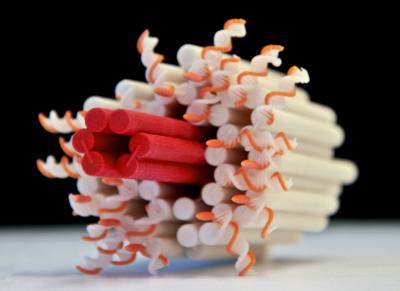Aplicaciones de Nanotecnología
Este blog está dirigido a la divulgación de los avances hechos en el campo de la aplicación de las nanociencias. Diseñado para su uso en Google Chrome.
Categorías
28/11/12
25/11/12
DNA Nanotechnology Helps Construct Synthetic Membrane Channels
As reported in the journal Science, physicists at the Technische Universitaet Muenchen (TUM) and the University of Michigan have shown that synthetic membrane channels can be constructed through "DNA nanotechnology."
This technique employs DNA molecules as programmable building materials for custom-designed, self-assembling, nanometer-scale structures. The researchers present evidence that their nature-inspired nanostructures may also behave like biological ion channels. Their results could mark a step toward applications of synthetic membrane channels as molecular sensors, antimicrobial agents, and drivers of novel nanodevices.

To read more about this article, please visit AzoNano
This technique employs DNA molecules as programmable building materials for custom-designed, self-assembling, nanometer-scale structures. The researchers present evidence that their nature-inspired nanostructures may also behave like biological ion channels. Their results could mark a step toward applications of synthetic membrane channels as molecular sensors, antimicrobial agents, and drivers of novel nanodevices.

This 3-D print shows the structure of a functional synthetic membrane channel constructed through DNA nanotechnology -- that is, using DNA molecules as programmable building materials for custom-designed, self-assembling nanometer-scale structures. This DNA-based membrane channel consists of a needle-like stem 42 nanometers long with an internal diameter of just two nanometers, partly sheathed by a barrel-shaped cap. A ring of cholesterol units around the edge of the cap helps the device "dock" to a lipid membrane while the stem sticks through it, forming a channel that appears capable of behaving like a biological ion channel. The device is formed by 54 double-helical DNA domains on a honeycomb lattice. (Credit: Dietz Lab, TU Muenchen; copyright TU Muenchen)
To read more about this article, please visit AzoNano
Dip Pen Nanolithography
What is DPN?
Dip Pen Nanolithography (DPN) is a direct write, tip based lithography technique capable of multi-component deposition of a wide range of materials with nanoscale registry. DPN can fabricate multiplexed, customized patterns with feature sizes as small as 50 nm or as big as 10 µm on a variety of substrates including glass, plastic, gold and silicon. Using arrays of “pen” tips, these features can be printed over large areas, with pattern design and fabrication often taking less than an hour to complete. DPN is a powerful yet simple-to-use benchtop technology that delivers direct write patterning capabilities without the need for a cleanroom, master stamp or photomask. With the ability to operate under ambient conditions and deposit features with sub-cellular resolution, DPN can successfully print organic, inorganic, and biological materials (including proteins, nucleic acids, lipids, hydrogels, alkanethiols, silanes, polymers and nanoparticles) in complex user-defined patterns. Features generated by DPN are very uniform, so assays constructed with these features deliver exceptional reproducibility.
Suscribirse a:
Entradas (Atom)
